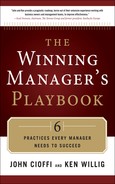The Value of This Chapter
What Most Managers Do
Our experience repeatedly has demonstrated that most managers don’t give any real thought to serving the right customer. Although they want more customers, these managers focus on the quantity of customers or sales, rather than the quality or nature of those customers.
As a result, they pursue everyone as a customer, employ sales strategies that simply won’t work with many of those prospects, create operational activities that don’t work for many of their new customers, and create a culture that is not focused on the correct goals. As a consequence, these managers put their careers at risk.
What Winning Managers Do
Winning managers know that not everyone is a good customer. Quite simply, they know that their company might not be able to provide the things that certain customers want.
Rather than try to satisfy everyone, which is impractical, these managers focus on the customers that they can serve in an exemplary way. They first clarify or define the characteristics of their “right customers,” and then they create strategies, sales and operational processes, and cultural practices that are all designed to serve those customers.
This story could be the introduction for a chapter on customer service. We could shower you with stories of exceptional service and urge you to create a culture that is customer centric.
And indeed it is, at least in part, just that—a chapter on dealing effectively with your customers. But it is more than that, because we want you to actually design as well as conduct your operations with the customer in mind.
This may require a modification to the way that you now do business. More specifically, you may often think about ways to improve your operation, but do you define improvement in terms of your clients’ needs or yours?
For example, you might create invoices in a format chosen by your bookkeeper rather than in a format that is understandable to your client (as was done by one of our former banks, emphasis on former). Or, you might package four widgets to a bundle, because that’s the way you’ve always done it, even though the customer might need only three at a time.
Our lady check out person obviously didn’t have a clue about her customers’ true needs. In fact, we doubt that she’d even consider them to be her customers—that would imply a type of ownership.
On the other hand, if she had been a customer advocate, she might have tried to make the check out experience an easy one, not an exercise on how to be baffled. Or, at the very least, she might have brought some empathy and good cheer to the conversation. But she was poorly trained, and the store missed an opportunity to impress a customer and earn loyalty.
Building your company around your customers requires you to think quite differently than the cashier in the Pike Place Market. It requires you to consider your customers as the architects of your business, and consequently compels you to design your entire firm to serve those customers.
This is a lesson learned by virtually all successful sole proprietors. Without a group of multi-skilled and multi-functional coworkers, the successful sole proprietor focuses on a specific segment of the market and learns how to serve that market in an exemplary way. Thus, the successful sole proprietor (who also is the entire company) adopts procedures and habits that are designed to serve customers in such a way as to ensure the proprietor’s success.
This notion is oftentimes lost in larger firms. Once we move from the successful sole proprietorship to a larger firm, we find processes that may be implemented for internal benefits, managers that may focus on the growth of their own empires, and employees that may focus only on the easiest means of completing their particular jobs. The customer may be virtually forgotten, at least as a focal point.
We all know that we need customers, and we all know that we have to serve the customer in some good way. But how many of us structure our company in the best interest of the customer? Don’t we often structure things to be convenient for us, and hope that it works out okay for the customer? Is okay good enough?
We urge you to consider a modification in the way that you do business. Depending upon your current status, this could mean only minor variations to your current structure and processes or, alternatively, something much more significant.
There are five steps, or building blocks, for building your company around your customers. All of these steps can be accomplished by virtually any business.
1. Define the right customer.
2. Create the right strategies for that right customer.
3. Create a sales process to secure and serve your right customers.
4. Create an operations process to serve your right customers.
5. Constantly build the culture.
